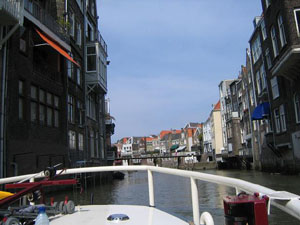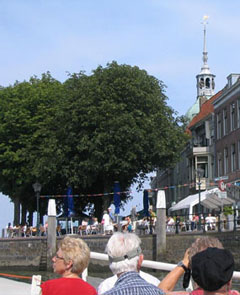Visit to the historic city in the Netherlands,"Dordrecht"(January 27, 2006)
Miyuki Nagashima
Graduate Student of Osaka School of International Public Policy, Osaka University
The Netherlands has been concentrating on the conservation and renovation of historical buildings, as one of the governmental policies in the field of architecture and urban planning. The Historic Buildings and Ancient Monuments Act was enacted in 1988. In the Netherlands, there are more than 55 thousands buildings such as city halls, bridges, churches and museums, which are designated as gancient monumentsh.
During my stay in the Netherlands in 2005 as an academic Ambassadorial Scholar sponsored by the Rotary Foundation, I visited Dordrecht which was the hometown(in his youth) of my host Rotarian,Roel van de Weg. Dordrecht, the oldest city of Holland, has a historical inner city and is surrounded by several mighty rivers including the Old Maas river. It is situated in the southwestern part of the Netherlands. The harbors in Dordrecht have been in the past the busiest river points of Europe with boats and ships not only from the Netherlands but also from all over Europe. Along the canals in the city, there are traditional buildings and houses which made me feel to have gone back deeply in history. In Dordrecht, there are about 1000 buildings, in particular houses but also old churches, which are designated as historical buildings.
At the Dordrecht Museum, there are several 17th to early 20th century paintings
from Dordrecht , especially I like the paintings about gcityscape g in
Dordrecht at that time. I am impressed by the fact that people successfully
preserved the historical buildings. For example, when I compared the glandscapeh
which I saw this year (please see the picture I made in 2005), with the
painting of the building, such as the clock tower with bell and the cafe
and with the big trees painted in 1886 by Johan Barthold Jongking, I was
really impressed by the fact that they are almost the same! I felt like
slipping back in time to around that time.

At the Open Monument Day, held in the second weekend of September, the
ancient monuments throughout theNetherlands, which are normally closed
or partly open to visitors are open to the public free of charge. Every
year, there is a special theme and this year (2005) it was gReligious
Heritageh. The information about all these buildings is available at the
tourist information office of each city.@Please visit the website of the
Dordrecht Museum at http://cms.dordrecht.nl/dordt?nav=wqbjEsHaKpPGbCAofB to see the drawings by Johan Barthold Jongking.
Comments from my host Rotarian, Roel van de Weg
What a surprise that you wrote an article about Dordrecht! I was really flabbergasted, how come? What was the reason for writing this article? To stress the fact that in Holland a lot is being done to preserve these remnants of the past? Thatfs right but it is a very costly affair! You wrote: that the website of the organisation which preserves the historical house (this house belongs to your sponsor Rotarian, Professor Hatada) Can you please explain this to me, which organisation, which historical house ,where (Osaka?) .
I looked also at the website you mentioned about Dordrecht, yes that is really a beautiful painting by Jongkind , and I remember that you took a picture when we passed that building by boat. I agree it looks if nothing has changed : you are right, even the trees like more or less the same !!!!!
But I am very proud of you writing about Dordrecht,- my home town - on a website in Japan!!
Roel van de Weg grew up in Dordrecht , finalized secondary school in 1958 (at the Johan de With Gymnasium,Dordrecht) , graduated at the University of Amsterdam (MSc.Physical Geography and Soil Science),after which he worked in the field of developing cooperation first 15 years in Asia and Africa, later from his base town Wageningen (The Netherlands) .He is Rotarian since 1991 and member of the R.C. Wageningen-Bergpoort (district 1560)